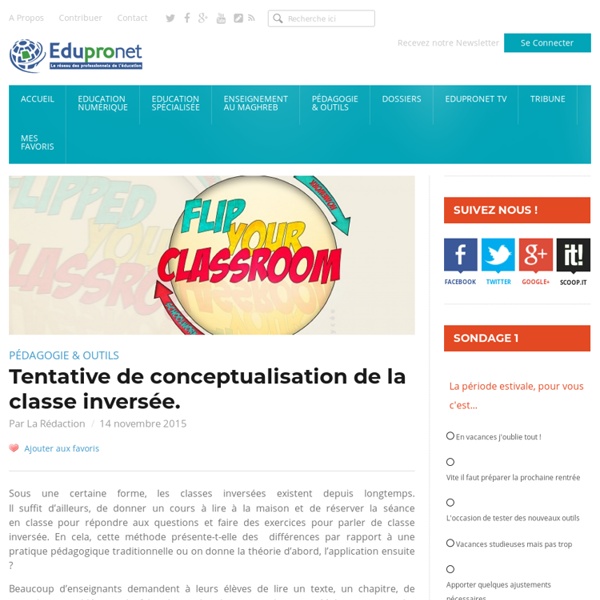



http://edupronet.com/tentative-de-conceptualisation-de-la-classe-inversee/
Related: Former, Conception, Ingénierie formation • CLINE 2 • La classe inversée • CLASSE INVERSEEMaking It Work: Today's Jobs Require Tomorrow's Skills During a terrific summer filled with conversations with family and friends — and attending education conferences around the country — I discovered that all talks involving education are united around one common objective: empowering students with skills to compete in today’s fast-paced and dynamic business environment. During June, July, and August, I heard the same question asked in many different ways: How do we expect our students to compete in today’s global economy when we are teaching them as if they’re living in yesterday’s business world? Today’s jobs require tomorrow’s skills. Ask any business leader and he/she will tell you — for a student to succeed in today’s marketplace, he/she needs to have highly developed critical thinking skills. It’s not enough to memorize facts to do well on a test, obtain a college degree, and expect that to guarantee a career-entry ticket. To secure a good job, students must be able to think creatively, communicate well, and know how to collaborate.
A critical review of flipped classroom challenges in K-12 education: possible solutions and recommendations for future research Flipped classroom approach has become a popular pedagogy in many education institutes around the world. The basic notion of flipped classroom approach is to deliver the teacher’s lectures before class through online videos, in order to free-up the in-class time for active learning and problem solving activities. The use of flipped classroom approach has been extensively studied, especially in the contexts of higher education. When compared the learning outcomes with traditional teaching, the previous reviews suggest that flipped classroom approach can improve student performance or at worst do no harm to student learning. In the published research of flipped classrooms, only a few studies (e.g., Gundlach et al. 2015) reported that students in traditional classroom preformed significantly better than the students in its flipped counterpart.
Five Time-Saving Strategies for the Flipped Classroom A few months ago, I heard a podcast by Michael Hyatt, a best-selling author and speaker who helps clients excel in their personal and professional lives. This particular podcast focused on how to “create margins” in life to reduce stress and avoid burnout. Quoting Dr. Richard Swenson’s work, Hyatt defines a margin as “the space between our load and our limits.
After 100 Years of the Same Teaching Model It’s Time to Throw Out the Playbook – Education Rickshaw In looking back at my parents’ education in the 1950s and 60s, and my own education in the 1990s and 2000s, I worry sometimes that despite the huge advances that we’ve seen in technology, not much has changed when it comes to how we view learning and how we design learning environments. The transmission model of education is still the name of the game, although in some circles there are signs of its erosion. I would like to take you on a journey in this post, starting from the 1950s banking model (Freire, 1968) of instructional design, before comparing it to my own schooling experiences as a digital native at the turn of the century. Then, finally, I would like to share my vision for C21 learning, and propose some ways that we can move forward so that we are meeting the needs of today. When my parents went to school…. In each of these infographics, students are shown as (S) and teachers as (T).
Power-Up: Flipping Your Classes ‘This course blew me away, it was more than I expected on several levels and it really got me charged up to plow ahead with flipping. Without a doubt I will be taking more courses with you so I'll say "until the next time" ’ Robert Ransley The Anglo House Academy Los Santos de Maimona, Spain In Flipping Your Classes you can expect: 11 Indicators of Excellence in Instruction (Flipped or Otherwise) In 2013, the Flipped Learning Network published an official definition of Flipped Learning. Along with this definition, the FLN defined these 4 Pillars of Flipped Learning, revolving around the acronym, F-L-I-P: The 4 Pillars of Flipped Learning are … Flexible EnvironmentLearning CultureIntentional ContentProfessional Educator
Learning Battle Cards: A New Tool For Instructional Designers One of the biggest challenges for Instructional Designers is to keep track of constant changes in Training and Development (T&D). You know how to handle workshops and seminars, but do you know how to match them with a back channel or community in practice? Do you know how to use big data to shape your Training and Development plans, or how to engage virtual agents in developing skills of people you are responsible for? Many of us educators know or remember only a few Training and Development methods; and even when learning about new methods, we are used to stick to those we are most familiar with. There are at least 2 barriers limiting the optimal usage of Training and Development methods by educators: Knowing the method.Understanding how to effectively use it.
7 must-knows from blended learning’s early adopters #4 Expand the Conversation about Cultural Relevance More and more “mavericks” are focusing on determining best practices for weaving cultural relevance into personalized and blended learning environments. As one educator from District of Columbia Public Schools put it, this should be grounded in conversation. “It shouldn’t just be a class or a book. We Didn’t Know What We Didn’t Know: Flipped Learning 3.0 – Flipped Learning Global Initiative By Jon Bergmann and Errol St.Clair Smith Pop Quiz: Most educators know about the Socratic method. True or false? Let’s go with true.